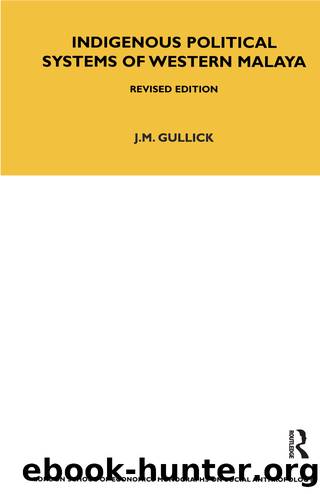Indigenous Political Systems of West Malaya by J. M. Gullick

Author:J. M. Gullick [Gullick, J. M.]
Language: eng
Format: epub
ISBN: 9780367716929
Google: kAcwzgEACAAJ
Barnesnoble:
Publisher: Taylor & Francis
Published: 2021-03-31T00:00:00+00:00
In Selangor the situation was different in that the royal lineage held all the district chieftainships. But the same tendency to fission appeared whenever the question of appointing a new district chief arose. There was a conflict between the inclination of the Sultan (or his more powerful backers) to concentrate power and office in the hands of his close kinsmen and the contrary tendency of collateral branches of the royal lineage to appropriate a district chieftainship, once obtained, as a hereditary fief to be held by the same line for ever. Selangor consisted of five districts, each a separate valley running down to the sea. The two outlying districts at the extreme north and south had become the hereditary fiefs of two collateral branches of the royal lineage. In the three central districts (Selangor, Klang and Langat) the situation was more fluid and gave rise to a celebrated quarrel in the i86oâs. In the reign of Sultan Mohamed the Klang district had been assigned to his son, Raja Sulaiman. At the death of Raja Sulaiman his son, Raja Mahdi, claimed to succeed to his fatherâs district. The real power rested with a wealthy chief, Raja Jumaâat, who persuaded the Sultan to give the Klang district to one Raja Abdullah, a brother of Raja Jumaâat. Although Raja Mahdi was the old Sultanâs grandson, he represented an offshoot from the circle around the Sultan headed by the all-powerful, Raja Jumaâat. It was a conflict between the tendency to concentrate power in one line and the tendency to divide it between several lines: The double broken line indicates the opposition between âhaves' to the right and 'have notsâ to the left. The âhaves' were a coalition of outsiders associated only by affinal ties. Raja Abdullah and Raja Juma'at were sons of a member of the Rhio branch of the royal lineage and were regarded as outsiders by the local-bom faction. Tunku Kudin was a brother of the Sultan of Kedah. In the civil war of 1866-73 one faction was led by Tunku Kudin and included the sons of Raja Abdullah of Klang; the other was led by Raja Mahdi and included to a greater or less extent all the sons of Sultan Mohamed and of Sultan Abdul Samad. Irregular as the situation is, it shows the tendency of a group around the throne to exclude the wider group of members of the lineage from the fruits of power and office.
Download
This site does not store any files on its server. We only index and link to content provided by other sites. Please contact the content providers to delete copyright contents if any and email us, we'll remove relevant links or contents immediately.
Adding Value to Policy Analysis and Advice by Claudia Scott; Karen Baehler(456)
Sociological Perspectives of Health and Illness by Constantinos N. Phellas(444)
Race and American Political Development by unknow(441)
Human and Global Security : An Exploration of Terms by Peter Stoett(425)
American Government and Politics Today by Steffen W. Schmidt Mack C. Shelley Barbara A. Bardes(424)
Control Of Oil - Hardback by Kayal(407)
Entrepreneurship Education and Training: The Issue of Effectiveness by Colette Henry Frances Hill Claire Leitch(364)
The Catholic Church and European State Formation, AD 1000-1500 by Jørgen Møller(355)
Materializing the Middle Passage by Jane Webster;(349)
The World According to China by Elizabeth C. Economy(343)
Left Is Not Woke by Susan Neiman(328)
Turkey's Relations with the West and the Turkic Republics: The Rise and Fall of the Turkish Model by Idris Bal(313)
Theories of Counseling and Psychotherapy: A Case Approach by Nancy L. Murdock(313)
Cross-Cultural Child Development for Social Workers by Lena Robinson(306)
Japan's Ainu Minority in Tokyo by Mark K. Watson(297)
Advances in Child Development and Behavior, Volume 37 by Patricia J. Bauer(295)
Laboratory Life by Bruno Latour(294)
Beyond Service: State Workers, Public Policy, and the Prospects for Democratic Administration by Greg McElligott(284)
The Oxford Handbook of Museum Archaeology by Stevenson Alice;(275)
